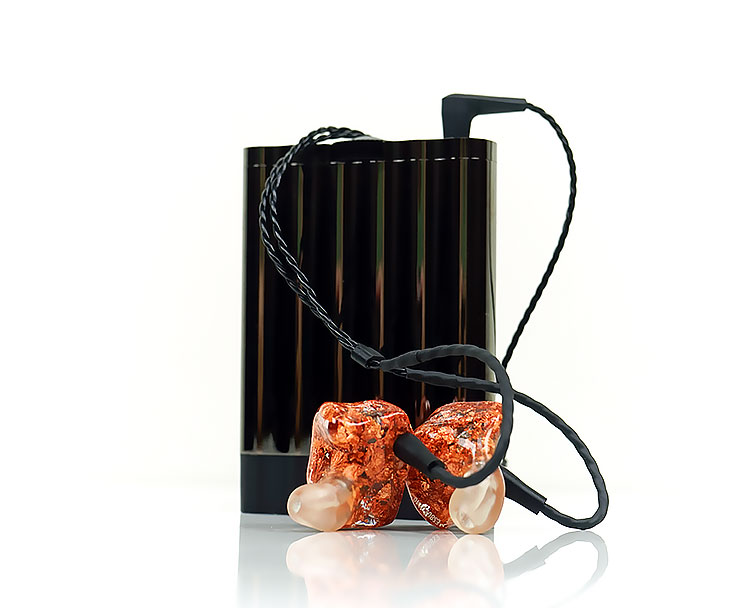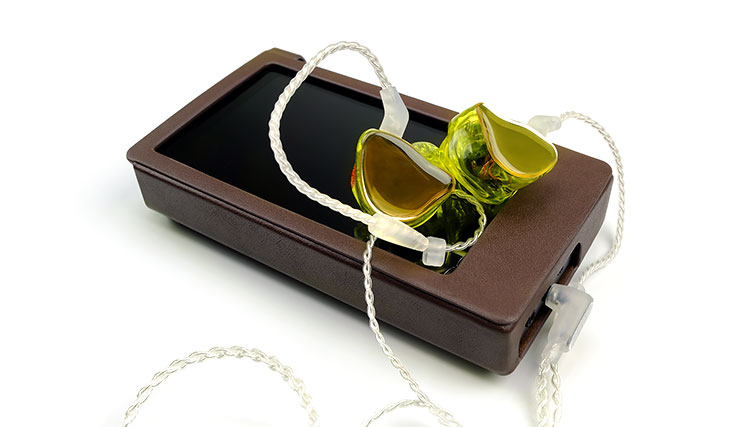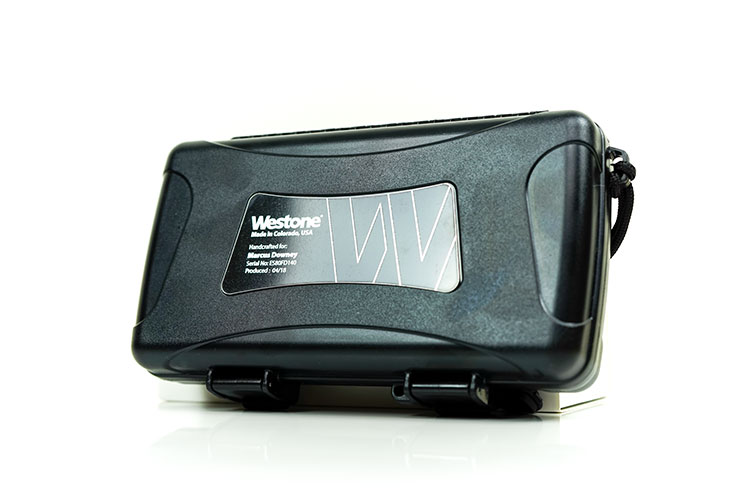Synergy
Efficiency
The ES80 is rated at 80Ω and 111dB and truth be told that is a slightly unusual rating for a modern-day multi-BA monitor. Typically, they come in at around 20-30Ω or lower. In fact, the Westone W80 has the exact same sensitivity rating at 111dB but is at a crazy 5Ω rating so quite the gap between both universal and custom 8-BA designs.
In reality, the 111dB rating is quite source-friendly. For smartphones and weaker DAPs, you will not have too much of a problem on volume though you will have to push up the slider a lot more than the likes of the Andromeda, Vision Ears VE6, or VE8. My own LG G6 got to around 50/80 steps before sounding a bit too loud and the iBasso DX150 is comfortable around 100 in low gain.
Dynamic Range
The output demands do mean that the dynamic range potential on the ES80 is going to be more optimal on more powerful DAPs and cables that significantly lower the resistance levels (8-wire is optimal for me).
As an example, Brute Force, a deep-hitting synth-wave track from Daniel Deluxe is punchier, clearer, and more expansive sounding on the ES80 from the Sony WM1Z than the LG G6. The G6 gets good volume but it sounds a little more compressed and softer sounding.
Noise
The really good news is the efficiency levels are such you will not pick up noise from external portable amps and DAPs like the FiiO X5iii which was the case with the W80. This makes the ES80 more flexible in terms of source and amp matching than the W80 and it will also deliver a much blacker background on more powerful sources.
Pairings
Sources
It is a bit of a red herring to talk about source synergy with the ES80 because it is a fairly transparent sound signature. Pretty much every DAP combination will bring to the ES80 a combination of their own well-known tonal tweaks combined with its amp stages performance in terms of resolution and power. You simply pair it with a DAP you already like the sound of.
If your DAP is bright sounding then chances are you will hear a little more treble presence and less bass body in the ES80’s signature.
If the source has a weak amp stage like the LG G6 then it is going to lose a bit of dynamic range and sound less snappy and as expansive as a more powerful and resolving DAP such as the Sony WM1Z. DAPs such as the DX150 will sound a little warmer with more depth than say the AK240.
If you want to keep some impressive low-end girth but inject a little more treble presence and detail then, by all means, grab the Sony WM1Z.
In summary, if you know the tonal bias of your source or amp then you should know what tonal changes may occur in the ES80 presentation when you pair it.
Power
The two more fundamental changes I found in the ES80 performance were actually the amount of output power and the choice of cable. Power is really all about going balanced with the ES80 and that will depend on how good your balanced output is on your source or amp.
My own recommendations included the iBasso DX200/150 and Sony’s 4.4mm balanced output on the 1Z with their muscular and more expansive presentations.
Cables
You can produce even more of a change in performance by moving from the stock cable to the ALO Audio Reference 8 cable. That SPC wire will deliver a heftier low-end and a more forward treble presence with much better clarity over the stock EPIC cable.
The change-up is even more substantial when you switch to 8-wire cables such as the Effect Audio Ares II custom build or their TOTL Janus. The additional dynamic range is just fantastic with both cables delivering far better high-frequency reproduction over stock.
However, the Janus will give you what I think is the best level of synergy with the ES80. The Janus’s midrange focuses on instrumental separation and its very organic timbre pairs so well with the already strong ES80 midrange signature.
Select Comparisons
AAW W900
Starting from $2075
Technical
The AAW W900 is a hybrid single 9mm dynamic driver and 8 BA custom monitor priced in the same ballpark as the ES80. The configuration is the single DD for the lows and 2 sets of quad BA drivers – one set for the mids and highs and one quad set for the “super highs”.
The W900 build is pure acrylic as opposed to the hybrid flex material and cold pouring acrylic design of the ES80. It is a little more pressure inducing on the ear canal than the super comfortable ES80 but the seal and secure fit are excellent. The nozzle is also a tiny bit longer than the ES80 though it also uses a deep-set multi-tube and horn-style bore finish.
Both the Es80 and W900 come with good quality cables. The ALO Audio SPC Ref8 with the ES80 and the Null Audio Ethos cable with the W900. The Ethos is a 26AWG 5N CGOCC-A Silver Plated Earphone Cable with a TPE Sleeve. The Ref8 has an edge sonically for me but the Ethos has suppler build-quality.
Performance
The AAW W900 is rated at 18Ω and 107.5dB. Compared to the 80Ω and 111dB of the ES80 it does not need the same level of power. However, that single dynamic driver does mean you can scale it a little. Side by side, on similar sources such as the iBasso DX200/150, there is a little volume adjustment to be made between it and the ES80. The ES80 does need a few dB more than the W900 to sound optimal.
Tonal Balance
Tonally, the W900 is perhaps even more neutral-sounding than the ES80 and certainly has a livelier treble presence. The dynamic driver in the W900 is actually quite restrained in its delivery.
You still get that immaculate level of texture and depth I come to associate with well-tuned dynamic drivers but it’s not the boomy mid-bass bloated type of sound. It is actually quite tight though a touch slower in its decay than the ES80 BA bass signature.
The ES80 also has a bit more mid-bass warmth than the W900 and less of a lower-mids dip so instrumental timbre is a little fuller and richer sounding. The W900 timbre is just that little bit leaner sounding with a little more upper-harmonic emphasis but not too much to detract from an otherwise very natural tone.
Vocals are a little further forward on the W900 compared to the ES80 though tonally they are a touch brighter and edgier sounding than the smoother and richer ES80 vocal performance. The W900 has a 2-4k dip but it is not huge and doesn’t suck out the air from the vocal delivery which I actually find to be quite expressive sounding on the W900.
The ES90 treble is not quite as pronounced as the W900’s tuning. The W900 has a more substantial 7k peak that brings a little more hardness in percussion attack and a slightly cooler higher-pitched instrumental timbre. In short, you will hear a lot more percussion presence on the W900 but the ES80 has the better treble body.
UE 18+ Pro
Starting from $1499
Technical
The Ultimate Ears 18+ Pro is a 3rd gen custom monitor based on a 6 BA driver and 4-way crossover design. It is unique for its top-side firing true Tone BA technology that is designed to bring out a more refined midrange than the first Gen 18+. It does start slightly cheaper than the ES80 by up to $400 but that can change depending on the final design choices.
In terms of build, I find the UE system design to be competent and easy to use. However, it is a bit lacking in design choices compared to Westone’s build options. Much like the ES80, (and the W900), the 18+ Pro uses a single horn style nozzle combined with a deep-set multi-bore design.
The materials are 100% acrylic and as such, they feel a little stiffer in the ear than the ES80. The seal and external noise attenuation is not as good as the ES80’s Flex tech. Both were based on the same ear impression STL files so it does come down to individual build processes at each company. The 18+ was just a touch looser in the fit also.
Cable
The 18+ Pro uses a lightly modified IPX connection system with a UE SuperBax Cable which is a partnership with Linum cable. This is a very low impedance SPC Litz wire which is tonally neutral, very light and flexible, and microphonic free. It is a good performer but cable rolling on the 18+ Pro is very limited so sadly I cannot tell you how much better it could with a higher grade wire. There the ES80 has a huge advantage.
Performance
The 3rd gen 18+ Pro is rated at 37.5Ω and 105dB. There is a bit of a difference on paper with the 18+ Pro requiring less power than the ES80. In real-world testing, you will the 18+ Pro marginally easier to drive.
In terms of volume on similar sources such as a DX200 or Sony WM1Z, the UE 18+ Pro sounded the slightly livelier and louder of the two at a similar volume which tended to negate the slightly better sensitivity figures of the ES80. It is marginal and not as a big a gap between the Phantom and the ES80 but the gap is there.
Tonal Balance
Though both are targeting stage musicians types the tonal balance between both these monitors differs in a few key areas. The most obvious tuning difference is the upper mids and lower treble which is quite dipped from 3-7k on the 18+ Pro compared to the ES80 which is further forward and livelier sounding.
The ES80 will sound a little more open in the mids and vocal presence as a result. That being said the UE18+ Pro vocals are further forward and a little more intimate sounding than the more neutral positioning of the ES80.
The timbre is relatively similar with more of a natural to neutral sound rather than bright or overly dark. However, the UE18+ Pro has a more pronounced 8-10k rise which injects a bit more upper-harmonic presence on percussion timbre than the ES80’s presentation. It does have a touch more sparkle but it’s nothing dominant nor does it add to a sense of airiness or massive levels of top-end extension.
The low-end tuning on both has a different emphasis. The ES80 is more linear with better sub-bass presence and power. It also has the better layering of the two. The UE 18+ Pro has a little bit more mid-bass warmth and impact but rolls off its sub-bass a bit more so lacks the same power and depth of the ES80.
Empire Ears Phantom
Starting from $1799
Technical
The Phantom is one of EE’s latest stars in their new custom monitor lineup and almost the same price as the ES80. This is an all-BA 5-driver monitor with 2 Low, 1 Mid, 1 High, 1 Super High and a 5-Way synX crossover network.
The EE design tool is a little messier than the Westone version but it has plenty of options. These options also include a wide choice of connections on its accompanying Effect Audio Ares II cable. The Ares II cable is a 4-wire UPOCC Litz Copper 26AWG cable. It uses a multi-sized stranding technique that delivers a fairly smooth and balanced sounding signature.
I would rate the build quality higher than the ALO Audio Ref8, especially in terms of microphonics and flexibility. Tonally they differ with the Ref8 offering something a bit punchier and the Ares II a bit smoother.
The build on the Phantom is 100% acrylic, but just like the W900 and 18+ Pro, it uses the same single horn style and the deep-set multi-bore system as the ES80. The Phantom, like the ES80 and 18+ Pro, was built from the same ear impression scans so the consistency to compare is there. I found the Phantom to be a slightly better seal than the 18+ and on par with the ES80’s seal.
The Phantom has a slightly longer nozzle than the flatter ES80 so it penetrates a little deeper. The single wide bore is also a little narrower than the ES80 version.
Performance
The Phantom does not have an official rating posted on their website so the best we can do is tell you how sensitive they are in comparison to the ES80. We do hope to get the official spec sheet in time for the full Phantom review coming soon.
What I can tell you from our testing that the Phantom is much more sensitive and easier to drive than the ES80. On moderately powered sources such as the Sony WM1Z, we were around 15-20 steps lower on the 3.5mm output in low gain.
Tonal Balance
It is early days in my testing of the Phantom so my observations are not as studied as a full review. What I can say is that the Phantom is more of a musical and organic tuning than a neutral reference tuning.
It has a bass to lower-mids bias that is thick and meaty with excellent texturing and a timbre that is natural to warm sounding. Lower pitched instruments have an excellent presence and weight and more elevated sounding than the linear and neutral positioning of the ES80.
Vocals
Male vocals on the Phantom are forward, “big” and rich in tone on the Phantom. However, female vocals seem to fall back in comparison and not as full-bodied sounding if the tracks have a busy lower pitched instrumental passage. It is not so noticeable if the track is stripped down and vocals give some space to perform.
The ES80 retains a more balanced approach to both male and female vocals. You could argue vocal performances are more consistent on the ES80 but if you prefer male vocals to the fore than the Phantom has the edge.
Treble
Treble on the Phantom is somewhat similar to the ES80 in tone and texture though not quite as neutral in its positioning. I have it slightly darker sounding than the ES80. Both have a slight even-harmonic bias and do not convey tremendous levels of sparkle and air. They do however have a smoothness about their delivery with very little peakiness and excellent body.
Staging
Staging is more depth and width on the Phantom with a forward lower-midrange and male vocal and an attenuated top-end. It paints a fairly intimate but detailed soundstage with excellent imaging. The ES80 is a more balanced reference tuning so its staging is a little more rounded and linear with great width, a more open midrange, and slightly better height.
Our Verdict
The Westone ES80 is an impressive reference-level custom monitor. The level of coherency from top to bottom is very nicely balanced and the timbre is natural but detailed to a level that is both involving and satisfying. It pairs really well with just about anything you throw at it.
The level of transparency is such that you can alter the tonal bias to reflect pretty much any source or amp paired with it. In particular, the ES80 is a cable king and it was a top idea to include the better performing Reference 8 cable from ALO Audio. It does take it to a very high level of sound quality indeed.
The ES80 also looks great with a unique design and physical feel that sets it apart from quite a few competitors. It is possibly one of the comfiest fits I have had to date. In all honesty, outside of pure preference such as bass heads and treble lovers, I can’t find a single thing technically wrong with the ES80 being used as a reference monitor.
Westone ES80 Technical Specifications
- Sensitivity: 111 dB @ 1 mW
- Frequency Response: 5 Hz – 22 kHz
- Impedance: 80 ohms
- Passive Noise Attenuation: Over 25dB
- Driver: Eight, Balanced-Armature Drivers, with a 3-way Crossover
- Cable: Replaceable MMCX Audio ™ Cable, 52”/128 cm






